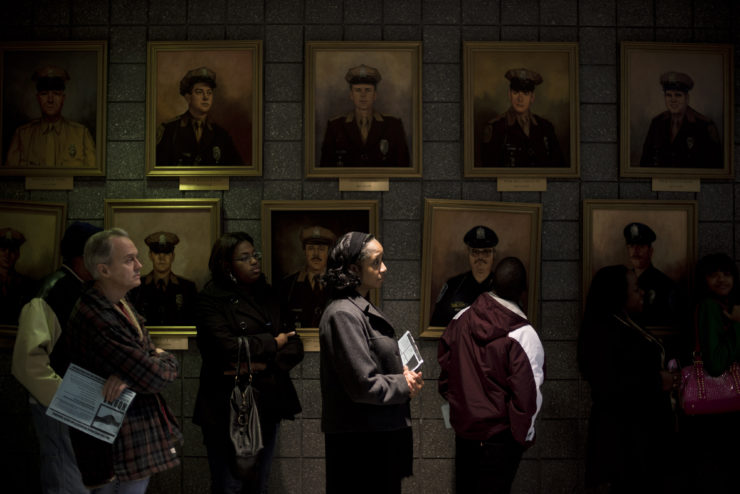
Voters line up at the Richmond Police Training Academy in Richmond, VA, to vote in Congressional District 3 in 2012
I often feel my job is to trick people into paying attention to the world around them. Beauty, light, and composition are my tools to draw one’s eye into the events and issues many would rather avoid.
When I started as a photographer, I described myself as a community journalist. At the Concord Monitor in New Hampshire I drove through the mountains to the state’s small towns, highlighting high school sports and town hall meetings. I started a column called “This Life” to spotlight everyday people and the often invisible moments of life. While spending days in the homes of strangers, living their lives with them, I learned a new and more important tool. Intimacy.
Years later, as a staff photographer for The Washington Post, I found myself on the deserted streets of D.C. an hour after American Airlines flight 77 hit the Pentagon. Before I knew the details of 9/11 I witnessed police frisking Sikh taxi drivers wearing turbans. Confusion and cultural ignorance surfaced. The Post sent me to Iraq and Afghanistan.
I had never considered the possibility of being a war photographer.
In Iraq, covering suicide bombings and roadside bombs became a gruesome daily routine. I quickly grew frustrated with the disconnect between the war and our readers. I based myself in Iraq for years trying, over and over, to connect the two. Trying to show the reality of war. Trying to get people to care.
I returned to the tools of the community journalist and started another column called “Unseen Iraq,” this time for the Post. Again, I focused on highlighting the seemingly invisible moments of life but this time for those involved in war. I never stopped covering the bloody reality of war, but realized that people wouldn’t care about the suffering of others unless they could relate to them first. Intimacy.
While covering the Middle East through the years, many people in the countries I cover have asked me how citizens of the United States see democracy. Most of them have wrestled with the concept in their own country, experiencing protests or war.
In Iraq, the first person to ask me this was a prostitute. Halla styled herself from posters of Britney Spears. She turned to prostitution after her civilian husband died in 2003— the result of a US bomb—to support her two kids. I answered her by mentioning ideas from the Bill of Rights. But, since then, the question has haunted me. To many people across the globe, democracy is intertwined with capitalism and money. To others, it means the ability to vote or freedom of speech. But the word democracy often is influenced by their own experiences with the U.S. military, drones, and corruption.
After covering failed and fledgling democracies in the Middle East, Asia, and Africa, I am intrigued by the definition of democracy in my home country. I see a disconnect between U.S. citizens, the government, and how people cling to the word “democracy.”
For the past few years I’ve felt compelled to return home to produce a long-term ethnographic study of democracy in the United States— a multimedia piece providing an intimate window into how the country’s citizens see democracy and the role of government in their lives. A project that will push people to pay attention to the politics that shapes their lives. A visual record that documents the state of democracy at this moment in U.S. history.
Who knew my year at Harvard would coincide with such an unusual presidential campaign and the rise of Donald Trump as a candidate for president. I took Jane Mansbridge’s democratic theory course in the Kennedy School, exploring political philosophers from Aristotle to Muhammad Asad. Matthew Desmond’s class, Poverty in America—a semester-long journey into the lives of America’s poor—was eye-opening. Many of my classes overlapped in ways I never expected. In Helen Vendler’s class on Yeats I read words lamenting, questioning, and remembering war. A class on Latin American cinema and the popular “First Nights” classical music class showed me different ways people express their feelings of hope, their attempts to be heard, and the struggle to change their lives.
Americans feel passionately about democracy. Many would die for it. And yet definitions vary widely and in often inconsistent ways.
Reconciling ideas about democracy from what I studied and what people believe has been a challenge. Taking advantage of my time at Harvard, I picked the brains of many of the most dedicated minds on this topic. I invited professors from Harvard and activists from Boston to my tiny Cambridge apartment for “democracy dinners” where, prodded by good wine and food, candles, and a record player, intense conversations on democracy unfolded.
There were disagreements and allegiances. Professors and authors who had never before met contributed their expertise and experiences to help find an answer to what democracy means today, and suggested questions for the people I will meet while on the road for this project. We discussed where one should go, what metrics to use, and what questions to ask.
My project on democracy in America began in North Carolina a day after the presidential election. I will be moving to a different county every month, living with people, asking questions, and having more democracy dinners along the way. Coverage has started with an @ourdemocracy Instagram feed—photos taken by people in the county to provide a window into their lives and their ideas of democracy in the U.S. I am paralleling their work with my own mix of photography and multimedia, trying to use photography, once again, to bridge a society so polarized we seem unable to see each other clearly.



